Violet "Frosty cherry"
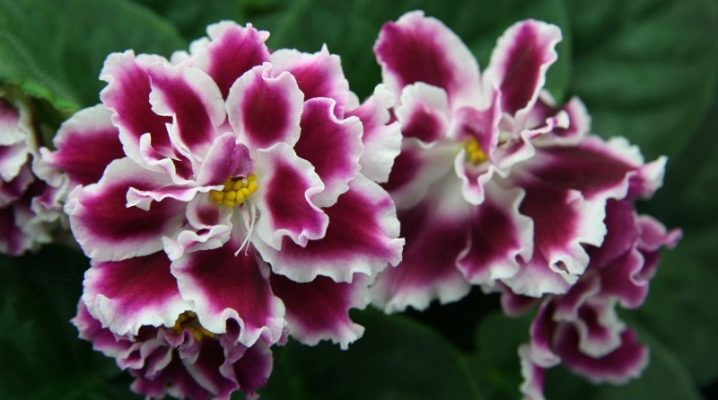
Most varieties of uzambara violets or saintpaulias are appreciated by both beginners and experienced growers for their unpretentiousness and spectacular appearance. One of the most famous varieties, capable of striking with extraordinary flowering, is the Uzambara violet "Frosty cherry". In the article, we will consider what is remarkable about this plant, what are its features and characteristics, how to care for the saintpaulia of this variety.

A bit of history
First, it should be noted that Saintpaulias, belonging to the Gesneriaceae family, are colloquially called violets. Despite the fact that the other name is Saintpaulia Usambar violet, these plants have nothing to do with the violet family and, therefore, with violets. However, in this publication, the colloquial designation "violet" will be used for the designation of saintpaulias, which will simplify the reading and perception of the text.
So, the Uzambara violet "Frosty cherry" - the result of long and painstaking work of the famous breeder K. Morev. The scientist Morev spent more than 10 years to develop this extraordinary variety.
It is noteworthy that in many photographs accompanying the description of the variety in various sources, the plants look different. In some photographs, the flowers of the "Frosty Cherry" can look bright and saturated, in others - light and even pale. Such differences are usually due to the characteristics of this saintpaulia, which, with any type of flowering, still makes an indelible impression.
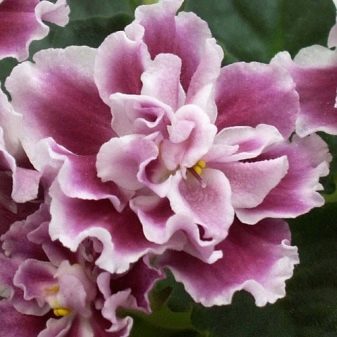
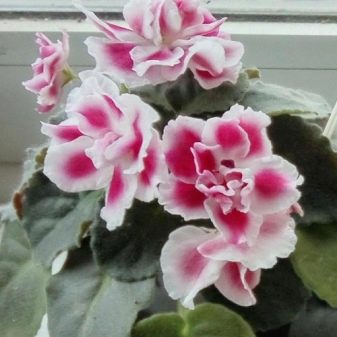
Description of the variety
Saintpaulia "Frosty Cherry" is a neat compact plant with simple pointed leaves with a heart-shaped base and large double flowers. Flowers of this variety can be up to 4 centimeters in diameter. In young plants, flowers are smaller in comparison with adult Saintpaulias.
The color of the petals is two-tone, combining a pale pink or cherry-red core and a white edging. As they grow older, both flowers and leaves of a violet of this variety begin to become darker, acquiring a more saturated color. The fact that the life cycle of flowers is coming to an end is evidenced by their darkening and wilting.
The variety "Frosty Cherry" is very popular with flower growers due to its unpretentiousness, as well as abundant and long flowering. The blossoming flowers stay on the plants in a heap and for a very long time.
With proper care, this Saintpaulia can bloom for up to 10 months.


A group of peduncles at the "Frosty Cherry" is formed in the center of the rosette. The buds are formed in large numbers, gathering in dense clusters.
The flowering phase usually occurs during the summer and winter periods. The color saturation of flowers depends on a number of factors, but primarily on lighting. The better this violet is illuminated during flowering, the brighter and more intense the color of its flowers will be.
Among other advantages of violets of this variety, flower growers note the simplicity of care, resistance to temperature extremes, and the massive formation of buds during the flowering period. Despite the fact that "Frosty Cherry" is considered to be a relatively young variety, it has perfectly established itself as a prolific, undemanding and non-capricious plant, the cultivation of which is within the power of even inexperienced plant breeders.
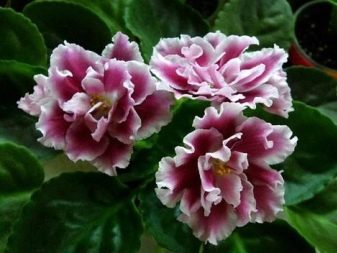

Care and conditions of detention
Despite the unpretentiousness of the plant to care, it is important to create the most comfortable conditions for it.With the right approach, Saintpaulia will grow and develop correctly, delighting with its regular, long-term and abundant flowering.
The basic rules for caring for the "Frosty Cherry" violet include conditions such as:
- correct lighting;
- stable temperature regime;
- control over the level of air humidity;
- compliance with the regime of watering and feeding.
Fulfillment of these conditions will not only have a beneficial effect on the plant, but will also significantly reduce the risks associated with the development of diseases and the invasion of pests. Failure to comply with the rules of care when growing saintpaulias inevitably leads to a sharp decrease in the immunity of plants, as a result of which they become vulnerable and susceptible to diseases and pests.
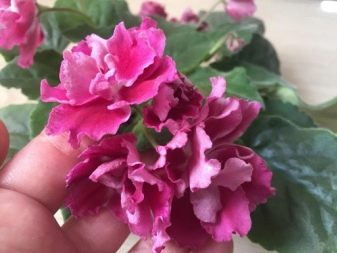

Correct lighting
Uzambara violet "Frosty cherry", like all Saintpaulias, is a light-loving plant. With a shortage of light, flower stalks begin to stretch out, the color of the flowers becomes pale, and the violet itself takes on a painful appearance.
To avoid problems associated with a lack of light, it is advisable to install plant pots on the windowsills in the east or west of the house. This arrangement will provide the violet with a sufficient amount of soft and diffused light.
It should be borne in mind that direct sunlight is detrimental to these flowering plants. The violet can get burned if exposed to direct sunlight during the day. To prevent this, in hot sunny weather, the plants should be shaded, even if they are located on windowsills in the east or west side.
To achieve the longest possible flowering, experienced growers recommend supplement the illumination of plants, artificially increasing daylight hours. For this, special phytolamps or ordinary fluorescent lamps are used.
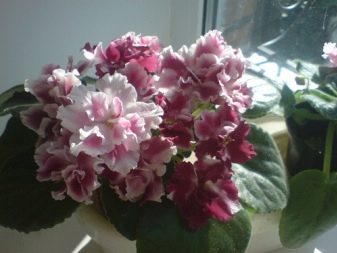
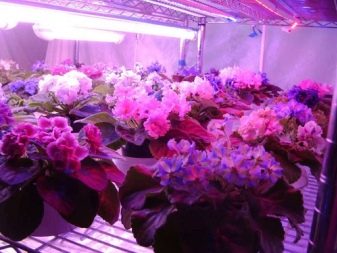
Stable temperature conditions
The correct temperature regime is very important for such heat-loving plants as Saintpaulia. They feel most comfortable in a room where the temperature is maintained at + 22 ° C. Temperature changes are very harmful for these delicate creatures.
A decrease in temperature to + 16 ° C and below has a detrimental effect on flowering. In this case, the plants completely stop forming flower stalks and buds. However, even a strong increase in temperature does not have the best effect on the condition of Saintpaulia flowers.
Under noticeably hot conditions, the violet flowers begin to become small, moving further and further from the standard.
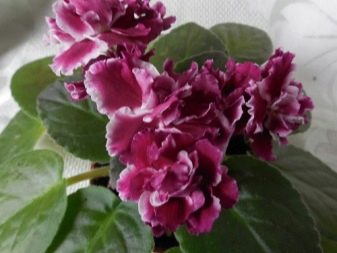

Suitable air humidity
Controlling the level of humidity in the room where the uzambara violets grow is very important for the full development and flowering of plants. Experienced growers recommend keeping an eye on so that the air humidity is stable at 50%.
An increase in air humidity up to 65% or more can lead to a deterioration in the appearance of flowers. In this case, they from intricate terry become simple and unprepossessing.
Do not increase air humidity by spraying violets. They endure such a procedure painfully, and in some cases they may even begin to rot.
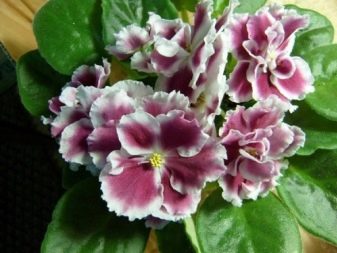
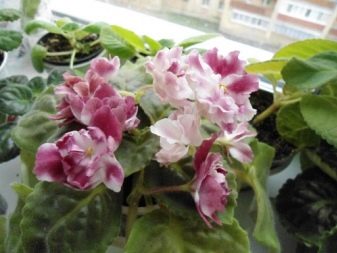
To prevent moisture deficiency in the air, it is advisable to install a wide bowl or tray with water next to the plants. As the water evaporates, it will saturate the air, replenishing the loss of moisture in hot weather.
It is also important to ensure that the air in the room is not only moist but also fresh. Providing an influx of fresh air allows not only good ventilation, but also regular ventilation, during which the plants should be temporarily removed from the room.
Cold air and drafts are very dangerous for delicate Saintpaulias.
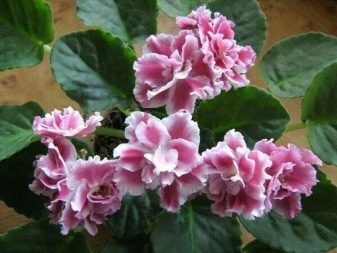
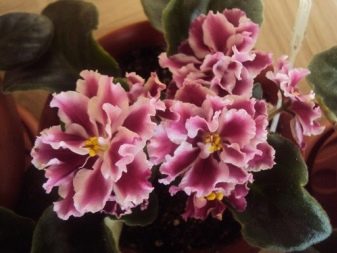
Watering and feeding
Uzambara violets painfully perceive irrigation and feeding disturbances. Plants should be watered as the soil dries up. The soil in the pot should be moderately moist, but not wet or damp.Excessive soil moisture can provoke the development of fungal infections and rot, so plants cannot be flooded.
During watering the stream of water is directed strictly along the edge of the pot, making sure that it does not fall on the leaves.
Watering is carried out only with warm, settled water.
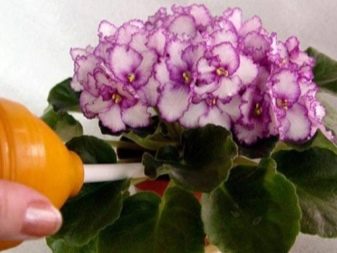
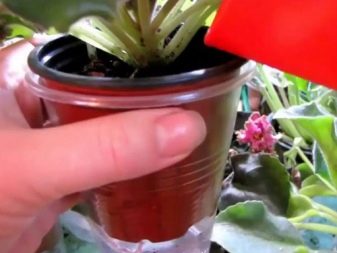
Saintpaulias are fed exclusively with complex fertilizers designed specifically for these plants. For the full development and flowering of violets, it is recommended to fertilize with mineral compositions about once every 2 weeks. The procedure should be carried out in the growth and flowering phases. During the rest period, feeding is stopped.
It is impossible to overuse dressings, since Saintpaulias painfully perceive the excess of nutrients in the soil. Inexperienced growers, striving to achieve more lush and abundant flowering, often make the mistake of overfeeding plants with fertilizers. As a result, a result is obtained that contradicts expectations, when violets begin to actively increase the green mass, but completely stop blooming.
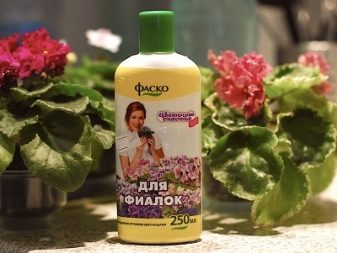
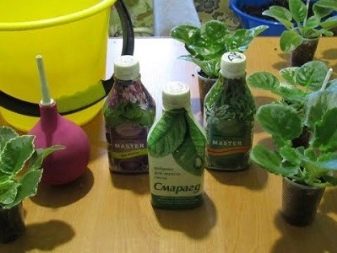
Breeding
Growing such a delightful variety of uzambar violets, which is "Frosty Cherry", a rare florist will not want to propagate this plant. The easiest way to propagate Saintpaulia involves using its leaves (leafy cuttings).
For breeding, you should choose a strong, well-formed and healthy leaf with a petiole at least two centimeters long. It is important that the leaf is cut directly at the peduncle with flowers of the most intense color. In this case, Saintpaulia will retain its varietal characteristics, and the florist will not receive what is called a violet sport. Sport is a term denoting the difference between violets and their varietal characteristics. Such Saintpaulias do not take on the color and shape of the leaves of the mother plants, which is considered a serious defect in flower growers.
The cut leaf is placed in a glass of water, where it is kept until roots are formed, or immediately planted in the ground. After planting, the sheet is covered with a glass jar, which is periodically removed for airing. In such conditions, very soon babies begin to form from the mother's leaf. Their development usually takes about 1-2 months, after which the younger generation can be transplanted into a larger pot.
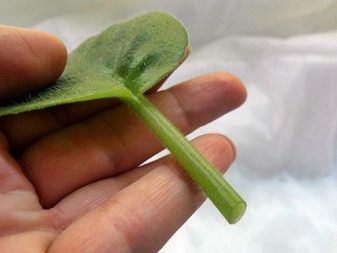
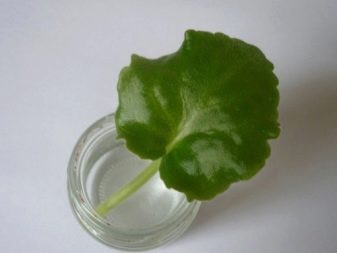
You can learn how to properly water violets in the following video.































The comment was sent successfully.